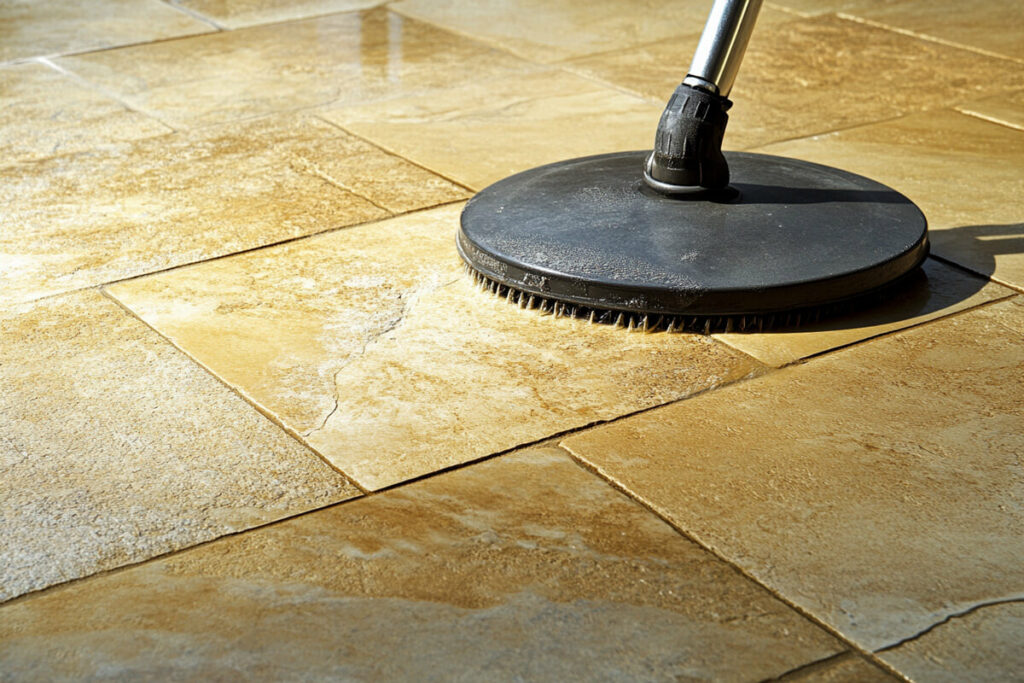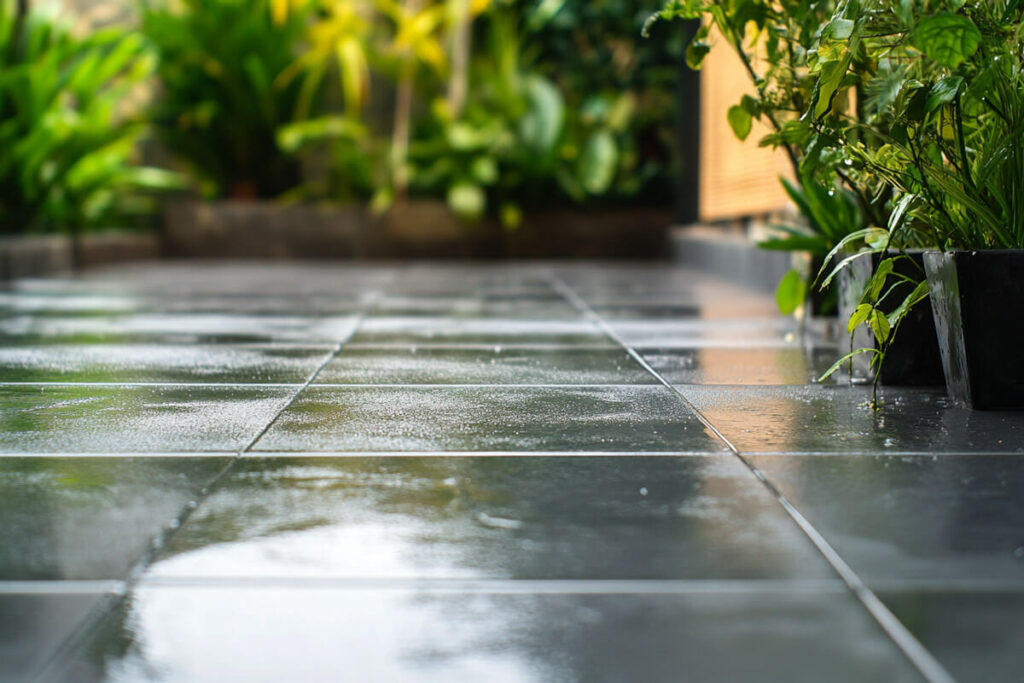We often hear one common question from our clients: “Should I choose sandstone or porcelain paving for my garden?” The answer to this question is not always straightforward, as this decision feels overwhelming due to the many factors to consider.
The primary difference lies in the origins of these paving materials. Sandstone is a natural stone quarried and cut into slabs, while porcelain is a manufactured product made from clay, sand, and minerals fired at high temperatures. This difference in production affects not only how each material looks but also its durability, maintenance, costs, etc. And that’s what we are going to talk about in this article:
- Durability of sandstone paving and porcelain paving in the UK climate
- How sandstone compares to porcelain paving in terms of maintenance
- What is more affordable porcelain paving or sandstone paving
- Slip resistance of sandstone paving and porcelain paving
- Aesthetic options for sandstone paving and porcelain
Durability of sandstone paving and porcelain paving in the UK climate
When it comes to paving, durability is one of the top concerns for UK homeowners. The unpredictable weather, including heavy rainfall and frosty winters, can have a negative impact on outdoor materials.
Sandstone is known for its strength and ability to withstand harsh conditions. Its natural composition makes it a good fit for the UK’s varied climate. However, because it is porous, sandstone can be more susceptible to weathering over time, especially if it’s not properly sealed. Frost can sometimes lead to cracking if water seeps into the stone and freezes.
Porcelain, on the other hand, is made to withstand extreme conditions. Its non-porous surface doesn’t absorb water, which reduces the risk of frost damage. Porcelain paving slabs are also resistant to scratches and wear. Whether it’s heavy rainfall or freezing temperatures, this material maintains a nice look.
If you’re looking for a material that requires minimal upkeep and can handle the UK’s challenging weather, porcelain may be the better option. However, with proper care, sandstone can also provide a durable and visually appealing solution for many years.

How sandstone compares to porcelain paving in terms of maintenance
We think anyone who has a garden patio doesn’t feel encouraged to spend a lot of time maintaining it. The easier it is to do – the better. If you are really looking into installing sandstone, than this aspect might slightly disappoint you. Sandstone is a natural material, which means it needs more care to keep it looking its best. Over time, algae and moss can build up, especially in damp areas. Regular cleaning, including the use of a pressure washer, can help remove surface dirt. However, to prevent stains and water absorption, sealing the surface every 2–3 years is a big must.
Porcelain paving is much easier to maintain. Its non-porous surface resists dirt, algae, and stains, meaning it only needs occasional cleaning with water and mild soap. Unlike sandstone, porcelain doesn’t require sealing, making it an ideal choice for those who prefer not to spend a lot of time maintaining their garden patio.
If you want to minimise time spent on upkeep, porcelain paving offers a clear advantage. Sandstone requires more frequent attention but can retain its beauty with proper care. The choice depends on how much effort you’re willing to invest in maintaining your outdoor space.
Aesthetic options for sandstone paving and porcelain
The visual appeal of your garden or patio plays a significant role in your choice of paving. Both sandstone and porcelain offer distinct aesthetic options, that meet different styles and preferences.
Sandstone’s natural composition has unique patterns and textures. No two slabs are identical, which is a strong point for people who don’t want an overly structured look. It comes in earthy tones such as Kandla Grey, Raj blend, and Mint Fossil, making it a popular choice for traditional and rustic garden designs.
Porcelain, being a manufactured product, provides a more uniform and refined appearance. It’s available in a wide range of styles, including those that mimic the look of natural stone or wood. This makes porcelain an excellent choice for modern and contemporary gardens where a sleek, polished look is desired.
If you want a patio with a natural feel, then sandstone is a great choice. Its variations in colour and texture bring warmth and authenticity to traditional settings. On the other hand, porcelain offers versatility, with finishes ranging from minimalist grey colours to interesting patterns that complement modern landscaping.
What is more affordable porcelain paving or sandstone paving
Budget is often a major factor when choosing between sandstone and porcelain paving. To make the best decision, it’s important to consider not only the initial purchase price but also the long-term costs associated with each material.
Sandstone paving is typically more affordable, with prices starting at around £20.00 per square metre. Porcelain, on the other hand, starts at a slightly higher price, averaging £34.00 per square metre. The difference in cost is mainly due to the manufacturing process, as porcelain requires more intensive production.
Besides the price for the material, sandstone is easier to cut and install, which results in lower labour costs. Porcelain, being denser and harder, often requires special tools and expertise, so, as a result, you have a higher installation cost.
While sandstone is cheaper upfront, it may require more frequent maintenance. Sealing sandstone every 2–3 years adds to its long-term expenses.
If budget is a big concern for you and you want to make your garden patio affordable for the wallet, sandstone will be a better choice.

Slip resistance of sandstone paving and porcelain paving
When choosing paving for outdoor spaces, safety is a key consideration, especially in the UK’s wet climate. Let’s examine how sandstone and porcelain compare in terms of slip resistance.
Sandstone has a naturally textured surface that provides excellent grip, even when wet. However, its slip resistance can vary depending on the finish and whether it has been sealed. Unsealed sandstone can become slippery over time due to algae buildup, particularly in shaded or damp areas.
Porcelain paving is designed with safety in mind. Many porcelain options come with a specially textured anti-slip surface, making them an excellent choice for areas exposed to frequent rain.
If safety in wet conditions is your priority, porcelain paving is the better option. Its built-in anti-slip properties and resistance to algae make it a reliable choice for patios, pathways, and other outdoor spaces.
Final word
We hope this guide helped you better understand what you need for your garden patio. However, before making the final decision, we highly recommend taking a few test samples to see how it might look in your space. At Natural Stone & Timber, we offer our clients free test samples of paving slabs. You can simply order it from our website or collect from one of our 4 depots in Portsmouth, Poole, Tadley or Winchester.

